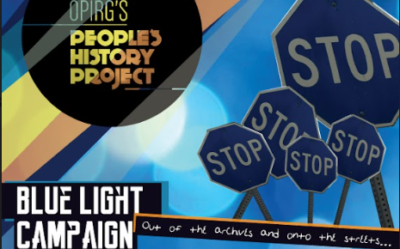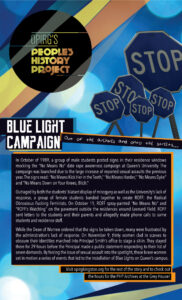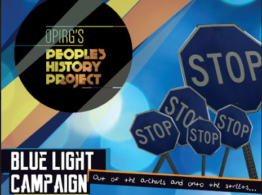
PeoPLES hISTORY pODCAST
EP #3. Blue Light Campaign aT qUEENS uNIVERSITY
Welcome listeners, you are tuned in to the People’s History Project podcast, run by OPIRG Kingston – a student run group with a focus on research, education and direct action on intersectional matters of social and environmental justice.
Before we begin, Content warnings for this episode include discussions addressing misogynistic attitudes around sexual assault on campus.
We would also like to acknowledge that this podcast is being recorded at CFRC, at Queen’s University, situated on traditional Anishinaabe and Haudenosaunee land. It is our collective responsibility to address the systemic oppression that Indigenous people face, and contribute to meaningful reconciliation and direct action, especially in light of the topic of this episode, and the related issue that sexualized violence disproportionately affects more Indigenous women, and so, please donate to or support organizations that advocate care and justice for MMIW across Turtle Island.
If you or a loved one need to reach out for local help, Sexual Assault Centre Kingston is a non-profit organization providing free, confidential, non-judgemental support for all survivors, and takes a trauma-informed, intersectional approach to their work (1). Learn more on their https://www.sackingston.com/ website.
The People’s History Project aims to recognize and preserve the important roles that Kingstonians and Queen’s students have played in many social movements throughout the years. The stories of people who participated in struggles for social and environmental justice – queer, Indigenous, Black, anti-racist, feminist, among many others – often go untold in “official” histories. The PHP seeks to engage with these stories by making accessible the rich history of social movements and resistance in Kingston. So if you’ve ever been curious about how Kingston as we know it came to be, you are listening to the right podcast.
Frat boys versus ROFF fEMINISTS
Today we are talking about how a vulgar act of misogyny on Queen’s campus lead to one of the greatest pushes for sexual assault activism and the installation of the blue safety lights across campus.
It all started in early October 1989, when a group of male students put several derogatory signs up on the windows of their dorms in Gord Brock to mock the “No Means No” campaign (2).
The signs, that were made clearly visible to pedestrians and passerbyers read:
“No Means Kick Her in the Teeth”
“No Means Harder”
“No Means Tie Me Up”
“No Means More Beer”
“No Means Dyke”
“No Means Down on Your Knees, Bitch”
When the Journal tried to interview some third floor Gord residents, they claimed their messages were merely a joke. They explained that they wanted to “lighten up” the rape awareness campaign and did this because of the overwhelming amount of info and pamphlets they got about date rape throguhout the campaign.
It seemed this group of guys learned nothing from the pamphlets.
The backlash was immediate. Students in McNeill, the all female residence across the street put up signs that read “No Means No,” “End Misogyny Now” and “No Means It’s Too Small.” (3)
Outraged by the student’s mysogyny and the univerity’s lack or response, a group of female students banded together to create ROFF: the Radical Obnoxious Fucking Feminists.
This group fought against these misogynistic attacks vigilantly, spray painting “No Means No” and “ROFF’s Watching” on the pavement outside the residences around Leonard Field.


- (1) SACK wants to work in a better capacity with Queens, but negotiating proper funding resources, space, and full confidentiality/ respect for their work isn’t easy.
(2) Huizinga, Raechel. “Calls For Sexual Assault Centre On Campus Unanswered For More Than Thirty Years”. Queen’s Journal, 2020, https://www.queensjournal.ca/story/2020-03-13/investigations/calls-for-sexual-assault-centre-on-campus-unanswered-for-more-than-thirty-years/. - (3) Hutchison, Penelope. “”No” Now Really Does Mean “No””. Queen’s Alumni Review, 2010, www.queensu.ca/alumnireview/articles/2010-02-04/no-now-really-does-mean-no.
An open letter to the Queen’s Community from the group describing their complaints in detail appeared in an on campus publication called Surface:
As a group of concerned women, we have felt compelled to respond to the blatantly misogynist attitudes and actions occurring on this campus. Attitudes and actions that encourage violence against women, and that this university has responded to with silence. As women within the structure of a university, many of us have tried to combat the violence, as well as the silence, through the official channels of protest provided by this university. And while we recognize the value of using these routes, we also feel that there are some things that require immediate and direct action. In response to the policy of silence perpetrated by this university regarding the symbolic and literal acts of violence against women on this campus, we, as a group of women, take full responsibility for the following actions.
The letter also listed actions that the group claimed as their own, including “reclaiming…the speed bump outside Clark Hall Pub, formerly referred to by the Queen’s Engineers as ‘the Golden Tit,’” removing nursing uniforms from trees and lamp posts that were covered in derogatory and sexist slogans like “no more dykes on bikes” and “all men-hating feminists need are good fucks from engineers,” and the spray-painted signs on the sidewalks that read “No Means No” and “ROFF’s Watching.”
More signs appeared in the windows of Gordon, Brockington, Leonard, McNeill and Morris residences until the Dean of Women demanded that they be taken down.

Further resources
- (4) Green, Alex. “The Emptiness And Inertia Of ‘Having Conversations'”. Jezebel, 2020, https://jezebel.com/the-emptiness-and-inertia-of-having-conversations-1844376876.
- Bansagi, Natasa. “Hope Dims For Off-Campus Blue Lights”. Queen’s Journal, 2015, https://www.queensjournal.ca/story/2015-01-16/features/hope-dims-campus-blue-lights/.
- “Surviving Rape Culture At Queen’s”. Queen’s Journal, 2013, https://www.queensjournal.ca/story/2013-02-12/opinions/surviving-rape-culture-queens/.
- The Queen’s Journal and Surface magazine, 1989-1990 at the Queen’s University Archives.
Many source links are in this spreadsheet. - Hutchison, Penelope, et al. “Letter To The Editors”. Queen’s Journal, 2020, https://www.queensjournal.ca/story/2020-03-13/editorials/letter-to-the-editors-march-13/.
By October 13 (of 1989), all of the messages had been removed from the windows. And attempts at reparation by the school began. Dons in Gordon House chose to host a gender issues awareness week where members of the AMS Gender Issues Committee and representatives from the Women’s Centre could organize workshops and discussions regarding rape and sexual assault.
The Main Campus Residence Council did not punish the Gord 3 residents involved, even after a letter from the Arts and Science Undergraduate Society encouraging them to do so.
Then, Queen’s University became the center of a media storm when the Toronto Star published a front-page article about the misogynistic signs. Over the next few days, regional newspapers such as The Whig-Standard picked up the story and national news outlets, like the CBC, broadcast discussions on their radio program, As It Happens.
The nine residents of Gordon House who posted the original signs in their windows sent a letter to both the Toronto Star and the Whig apologizing for their actions. The apologies were criticized by a number of students who wrote letters to the editor of the Journal. One such letter questioned the boys motives for writing the apology:
But what was the apology for? Who was the apology really aimed at? Are those responsible for the Gordon House signs sorry because of who they offended, or are they sorry they got caught? Evidence certainly points to the latter. Ask yourself, “if they are sorry- why did it take national media coverage to prompt the apology?”
The opinion section of the Journal was flooded with letters expressing tremendously polarized views on the signs, the boys involved, ROFF and the media storm that had broken out.
During the scandal, some people also criticized Queen’s administration for their inaction regarding both the signs as well as the issue of sexual assault on campus, pointing out Principal David Smith’s notable silence.
Fed up with his lack of response, on November 9, thirty women clad in scarves to obscure their identities marched into Principal Smith’s office to stage a sit-in. Surface published an article signed “Five Of A Group Of Women,” that stated the members of the sit-in were “not associated with ROFF, the Women’s Centre or the Gender Issues Committee,” and that “[s]ome women involved probably wouldn’t call themselves feminists.” Surface also reported that one observer made an “off-the-cuff” comment to a news photographer at the sit-in, saying “Go ahead and take all of the pictures that you want of those fucking feminist bitches, so that we know exactly who they are, so that we can rape them.” Over one hundred women were involved in the sit-in and a group of men supported by keeping vigil on the steps outside. (Now thats how to be a feminist ally! Using their privilege and physical power to protect and support the movement)
According to the Journal, a spokesperson for the group of women read out a list of seven demands, stating that:
We, the women of Queen’s, protest the misogyny of some of the men on this campus, and the refusal of the Queen’s administration to take action and speak out against this violence.
The demands included an investigation of Orientation Week and Homecoming; for the MCRC to be stripped of autonomy; for the position of the Dean of Women to be maintained; for further educational campaigns on sexual assault; for the Gordon House men to raise a minimum of $5,000 to go to organizations like Interval House that help women; for Principal Smith to “make a public statement denouncing the actions of the Gordon House men”; and that the administration provide funds for Kingston’s Sexual Assault Crisis Centre.
The Journal reported that Smith responded by stating that he had “written a letter to The Journal denouncing the actions in Gordon House,” but the women challenged his delay in making a public statement about the signs. The Journal reported that Smith claimed “the judicial processes in place at the school made it impossible for him to take further action beyond his personal statement,” and that the Chair of Queen’s Senate and can only respond to AMS judicial committee cases when they are referred to him by recommendations of the committee.” The women expressed their frustration with the judicial system, with one person stating “We don’t have faith in the system. The Judicial system at Queen’s is not going to stop the assaults.”
I found a phrase coined by Alex V Green: “conversational industrial complex” (4), it stalls real progress by rehashing conversations in circles, nothing gets done, and should be remedied by direct action. Leading task forces and following due processes doesn’t make sense if it never even fixes the bad behavior happening.
Another woman said the following: “I have a right to study safely, I have a right to live without fear. You cannot understand the fear. You are not always looking for the safest place to walk, you don’t know what it’s like to be scared.”
Principal Smith did call for the Principal’s Advisory Committee on the Status of Women to perform a review of Orientation Week and Homecoming, confirmed that the position of Dean of Women would remain and said he would “look into” funding the Sexual Assault Crisis Centre; funding of $10,000 was eventually donated in the new year. Smith, however, continued to insist that the women follow established procedures.
After twenty-nine hours, the women emerged from Principal Smith’s office. Before leaving, the spokesperson for the group announced from a second floor of Richardson Hall that:
We are leaving because we feel we have succeeded in making this an urgent, immediate and serious concern.
According to the Journal, over the course of the sit-in, “some of the women involved in or associated with the sit-in…received harassing phone calls and some women [were] confronted on the street while walking home.” One woman told the Journal that one caller had apologized for “what had happened,” and claimed that he had done “‘empirical studies’ in his women’s studies class which showed that, according to him, women scratch men’s backs when they’re having sex not because women enjoy sex- because they don’t- it’s because they want to get back at men for dominating them, for being on top.”
When tragedy struck Montreal on Wednesday, December 6, 1989, it acted as a wake up call for universities across the country to face the rampant misogyny on campus. During the “Montreal Massacre,” Marc Lepine entered the École Polytechnique and murdered fourteen women, claiming that he was fighting feminism and blamed feminists for his problems. At Queen’s University, memorials were held, the Principal and other officials made public statements expressing their condolences and students grappled with the ramifications of this incident. The Journal reported that twenty-seven buildings on campus were spray-painted with feminist slogans.
Alumni expressed their frustration in letters written to both the Journal and administration. On December 1, Queen’s alumni and former principal, Daniel R. Woolf, wrote a letter to the editor that was published in the Journal prior to the massacre, criticizing the administration’s lack of response:
Much of the actual behavior of the residence men involved in this incident- which I recognize was likely only a small minority- sickens me, and much as it did so 14 years ago as an undergraduate, I am more shocked by the apparent indifference shown by Principal Smith and the administration of Queen’s in refusing to take a firm stand against such incidents, other than eventually having the signs removed. Both of us enjoyed our years as students at Queen’s, and have always hoped that our daughter might study there eventually. But unless things change very much in the next few years, we would have a hard time recommending the Queen’s “undergraduate experience” to her. The administration of Queen’s University must take a firm stand against sexual harassment of this kind…. It is with deep regret that I must say that until it does so, we will be unable to participate in any alumni fund drives, and will urge other alumni to do likewise.
Similarly, on January 16, two brothers, both alumni, expressed concern about the state of women on Queen’s campus, understandably worried about their sister who was still a student. Their letter, published in the Journal, explained their position:
To demonstrate our support for the silence, we submit to you our cheque to the Alumni Annual Fund for zero dollars and zero cents. We will remain abreast of the situation through our sister and if the environment on campus improves, we will consider augmenting the contribution substantially. We rest concerned personally with the future of Queen’s.
The attention of Queen’s alumni had clearly been attracted and action was being taken to demonstrate their displeasure.
On January 30, the AMS Judicial Committee- composed of three men to preside over the hearing- adjourned the trial of the Gordon House nine. The students were accused of “violating the University’s Code of Conduct” as well as the AMS and MCRC constitutions by putting the signs in their windows. According to the Journal, the defendants hired a lawyer who claimed “his clients had not had sufficient time to prepare the case.” In early February, a judge from the Supreme Court of Ontario granted an injunction, ruling that the Judicial Committee must wait until March 15 before hearing the case. The lawyer informed the Journal that the committee “lacked jurisdiction to hear the case since no complaint had been filed within sixty days of the offence, as outlined in the AMS constitution.” March 23, the Journal reported that the hearing had been delayed once again; the complainants requested to adjourn until September 1 because they needed “time to seek independent counsel” due to “personal differences” with the AMS prosecutor. The Judicial Committee chose to postpone the trial until September 24. However, when it came to the scheduled date of the hearing, there was yet another problem. According to the Journal, a court order from an Ontario Supreme Court Judge ruled that the case would had to have been heard between March 15 and 30, 1990; as it stood, the “defendants argued that the committee would be in contempt of court if they went ahead with the proceedings.”
On February 9, the Journal reported that a plan was in place to build “emergency phones” by the following academic year. The legacy of these dedicated Queen’s students and members of the community- particularly the women who protested, wrote letters and conducted the sit-in- can be seen in the Blue Lights that help to keep students safe to this day.
Thank you for tuning into this episode of OPIRG Kingston’s People’s History Podcast. For more information on the story, check out the transcript on the OPIRG Kingston website.
If you would like to learn more from OPIRG about the People’s History Project or if you are interested in getting involved, follow us on facebook and instagram @OPIRGKingston and stay up to date.
Thanks for listening and make sure to tune in to our next episode!
(Originally written in July 2019 by Samara L, edited by Finn H. in 2022)
